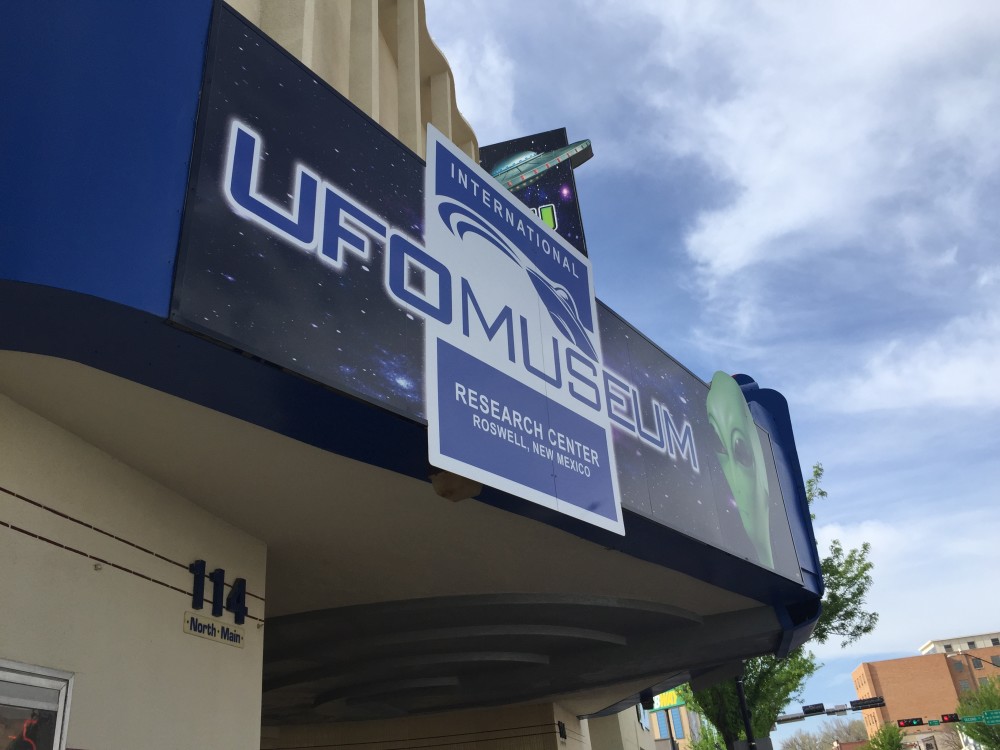Have you ever gazed up at the vast, starry expanse of the night sky and wondered if you were truly alone? Have you ever felt a sense of awe, perhaps even fear, at the thought of intelligent life existing beyond our planet? These are questions that have captivated humanity for centuries, and even today, in our age of scientific wonders, the possibility of extraterrestrial life remains a captivating enigma. In Roswell, New Mexico, a unique place exists that embraces this fascination with the unknown: the International UFO Museum and Research Center.

Image: commons.wikimedia.org
This fascinating institution serves as both a repository of knowledge and a platform for passionate exploration, dedicated to unraveling the mysteries surrounding unidentified aerial phenomena (UAP), more commonly known as UFOs. While the topic of UFOs invites skepticism and often stirs debate, the International UFO Museum and Research Center offers a space for respectful inquiry, inviting visitors to delve into intriguing accounts and engage in critical thinking about these extraordinary claims. It’s not merely a museum about flying saucers, but a testament to humanity’s enduring fascination with the possibility of extraterrestrial life and the countless questions that arise from such a profound concept.
Delving into the History of the International UFO Museum and Research Center
The International UFO Museum and Research Center’s story is intertwined with the famous “Roswell Incident,” which occurred in 1947. A rancher named William “Mac” Brazel stumbled upon debris scattered across his property near Roswell, sparking rumors of a crashed “flying disc” and igniting public fascination with the event. Although the United States Air Force later explained the debris as remnants of a weather balloon, the story continued to capture imaginations, becoming a cornerstone of UFO lore.
In 1991, drawing on this enduring fascination, the International UFO Museum and Research Center opened its doors, offering a space for visitors to explore this captivating tale. What began as a small museum showcasing local artifacts connected to the Roswell Incident has evolved into a comprehensive institution, encompassing a vast collection of artifacts, documents, and evidence related to UFO sightings and experiences spanning the globe.
Exploring the Museum’s Treasure Trove
The International UFO Museum and Research Center is not just a static collection; it’s a dynamic space brimming with intriguing artifacts, captivating stories, and thought-provoking exhibits. The museum’s most famous artifact is a fragment of the debris found on Mac Brazel’s property in 1947, which the museum claims to be a piece of the crashed “flying disc.” While the origin of this debris remains a subject of debate, it undoubtedly holds immense historical and cultural significance, symbolizing the beginning of the UFO phenomenon in Roswell.
The museum’s collection goes far beyond this one artifact, featuring a wide array of fascinating objects related to UFO sightings: from military reports and eyewitness accounts to photos, videos, and even alien-themed memorabilia. Visitors can view mockups of supposed UFOs, explore interactive exhibits that delve into the science of UFOs, and even experience what it would be like to encounter a UFO through immersive simulations.
A Hub for Research and Debate
The International UFO Museum and Research Center is more than just a museum; it’s actively involved in researching the UFO phenomenon. Through its research team, the museum constantly seeks to verify claims, analyze evidence, and advance the understanding of UFOs. Their research efforts have encompassed a wide range of areas, including the study of eyewitness accounts, the analysis of physical evidence, and the investigation of possible government involvement in the UFO phenomenon.
The museum also plays an important role in encouraging open dialogue about UFOs. The museum regularly hosts lectures, conferences, workshops, and other events featuring experts in the field, allowing visitors to hear different perspectives and engage in thoughtful discussions.

Image: thetrekplanner.com
The Human Element: Beyond the Science
While the museum explores the scientific and investigative aspects of UFOs, it also acknowledges the profound human element interwoven into this phenomenon. The stories of those who claim to have witnessed UFOs, the emotions they experienced, and the impact those encounters have had on their lives are often deeply moving and inspiring. The museum recognizes that the UFO phenomenon transcends mere scientific inquiry, touching upon our deepest existential questions about the universe, our place in it, and the possibility of life beyond our own planet.
Beyond the Museum Walls: An Ongoing Journey
The International UFO Museum and Research Center is more than a place to visit; it’s a testament to humanity’s innate curiosity about the unknown. The museum serves as a reminder that the search for answers about UFOs is ongoing – a journey guided by scientific inquiry, critical thinking, and openness to new discoveries.
The museum encourages visitors to think critically about the evidence, to question accepted narratives, and to explore the possibilities with an open mind. It’s a testament to the power of human imagination, the enduring pursuit of knowledge, and the boundless potential for discovery in the universe.
International Ufo Museum And Research Center
Getting Involved: A Call to Explore
Whether you are a seasoned UFO enthusiast or simply curious about this fascinating topic, the International UFO Museum and Research Center offers a unique and unforgettable experience. The museum’s website is a wealth of information, providing access to research materials, articles, documentaries, and interactive resources. You can also contribute to the museum’s ongoing research by sharing your own experiences or participating in online discussions.
The International UFO Museum and Research Center encourages visitors to join in on the adventure of exploring the mysteries of the universe, celebrating the human spirit of curiosity and our unyielding desire to connect with the unknown.





